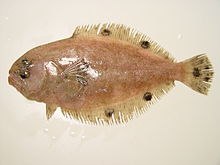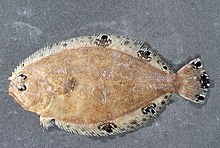
Citharichthys is a genus of flatfish in the large-tooth flounder family, Paralichthyidae. They have both eyes on the left sides of their heads. They are native to the oceans around the Americas, with a single species, C. stampflii off the West African coast. Most are found in relatively shallow depths, but the genus also includes species found in deep water and species that enter fresh water.

Large-tooth flounders or sand flounders are a family, Paralichthyidae, of flounders. The family contains 14 genera with a total of about 110 species. They lie on the sea bed on their right side; both eyes are always on the left side of the head, while the Pleuronectidae usually have their eyes on the right side of the head.
Gastropsetta frontalis, the shrimp flounder, is a species of large-tooth flounder, the only member of its genus Gastropsetta. It is endemic to the western Atlantic Ocean, from North Carolina to Florida, and from the northern Gulf of Mexico to Panama. It also occurs in The Bahamas.

Cephalopsetta ventrocellatus is a species of large-tooth flounder native to the Indian Ocean, from the Gulf of Oman in the west to the Andaman Sea in the east. Little else is known about this species. It is the only known member of its genus.

Cyclopsetta fimbriata, the spotfin flounder, is a species of large-tooth flounder native to the western Atlantic Ocean. It ranges along the Eastern coast of North America, from North Carolina in the north to the coast of Brazil in the south. It is abundant around the coast of Florida and in the Gulf of Mexico. It can be found among reefs and has a depth range of 20–230 metres.

Hippoglossina oblonga, is a flatfish and member of the large-tooth flounder family Paralichthyidae. This species has been placed in the genus Paralichthys by some authorities.
Thysanopsetta naresi is a species of flatfish in the large-tooth flounder family, Paralichthyidae. It is the only member of its genus Thysanopsetta . Thysanopsetta naresi is a demersal fish that lives in temperate waters at depths of between 90 and 170 metres. It can be found in the southeast Pacific Ocean, off the coast of Chile, and in the southwest Atlantic Ocean in the Patagonian Falkland region. It grows to around 15.1 centimetres (5.9 in) in length.
Citharichthys gymnorhinus, the anglefin whiff, is a species of flatfish in the large-tooth flounder family Paralichthyidae. It is a demersal marine fish that inhabits the mid to outer continental shelf of the western Atlantic Ocean, in both tropical and subtropical waters. It ranges from the Bahamas and Florida in the north to Guyana and Nicaragua in the south, though larvae samples have also been collected off the coast of Canada. It occurs at depths between 35 and 200 metres, but is most commonly found in shallower waters.
Citharichthys abbotti, the Veracruz whiff, is a species of flatfish in the large-tooth flounder family Paralichthyidae. It is endemic to the southwestern Gulf of Mexico, found on the Eastern Mexico Continental Shelf, with Veracruz to the south and the Rio Grande to the north.
Citharichthys amblybregmatus is a species of flatfish in the large-tooth flounder family Paralichthyidae. It is native to the western north Atlantic Ocean. It has been collected at a depth of 198 m (650 ft).

Monolene is a genus of small, mainly deepwater lefteye flounders from the Atlantic and East Pacific.

Trichopsetta is a genus of small lefteye flounders native to the western Atlantic Ocean.

Ancylopsetta is a genus of large-tooth flounders mostly found along the Atlantic coast of the Americas with one species found along the Pacific coast.

Etropus is a genus of large-tooth flounders native to the coastal waters of the Americas.

Hippoglossina is a genus of large-tooth flounders native to the coastal Pacific waters of the Americas. A single species, H. oblonga is found along the Atlantic coast of United States and Canada, but it is frequently placed in Paralichthys instead of Hippoglossina.

Paralichthys is a genus of large-tooth flounders. Most species are native to the coastal waters of the Americas, but P. olivaceus is from northeast Asia. The largest species reaches about 1.5 m (5 ft) in length.

Pseudorhombus is a genus of large-tooth flounders. With the exception of P. binii found off Peru, species in this genus are native to the Indo-Pacific. The largest species reaches 40 cm (16 in) in length.

Syacium is a genus of large-tooth flounders found in the Atlantic and Pacific Oceans. With the exception of S. guineensis from the Atlantic coast of Africa, all species are from the Americas. The largest species in the genus reaches 40 cm (16 in) in length.
Tarphops is a genus of large-tooth flounders native to the northwest Pacific Ocean.
Xystreurys is a genus of large-tooth flounders with one species, X. liolepis, found along the Pacific coast of North America from Monterey Bay, California to the Gulf of California and the other, X. rasile, found along the Atlantic coast of South America from Rio de Janeiro, Brazil to the southern tip of Argentina.












